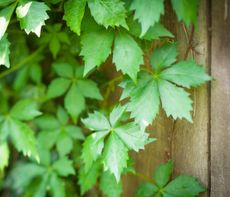Virginia Creeper Maintenance: Growing Info And Virginia Creeper Plant Care


A vigorous and fast-growing vine, Virginia creeper (Parthenocissus quinquefolia) is an outstanding plant for nearly any soil and light situation. Growing a Virginia creeper vine provides a nearly carefree addition to the landscape. Virginia creeper maintenance is limited to light pruning and tying up. Learn how to prune Virginia creeper vine and what problems and pests may be an issue.
Growing Virginia Creeper Vine
Virginia creeper produces one of the most spectacular color displays of fall. The five-pointed leaves are usually just an average green but turn a brilliant crimson once temperatures cool.
Virginia creeper can grow in sun to full shade, where soils are soggy to dry and even in lightly alkaline soils. The adaptability of the plant makes it suited for any site but care should be taken to keep it off wood siding and gutters.
The vine climbs and adheres to vertical surfaces with aerial roots, and the weight of the plant could pull off boards and misalign gutters. If you are trying to cover an area with the vine, plant several at once, as the plant does not branch well.
Use plant ties to help it start its climb up a vertical surface. You can also use it as a ground cover, much like ivy or vinca. This is a perfect plant for a novice gardener since Virginia creeper plant care is minimal and it is a very forgiving vine.
Virginia Creeper Plant Care
Virginia creeper is a carefree plant. It is a deciduous, perennial vine with a woody stem. The plant will bloom from June to July with green, inconspicuous flowers. They turn into round ball-like fruits, which persist on the vine and add interest. You can cut these off if you have children, as they are highly toxic. Birds will enjoy them if you leave them on the vine.
Watch for leafhoppers, scale, and Japanese beetles. Treat with the appropriate insecticide to quell these types of invaders. The plant may need supplemental water during extended periods of drought but can tolerate short periods of dryness.
Gardening tips, videos, info and more delivered right to your inbox!
Sign up for the Gardening Know How newsletter today and receive a free download of our most popular eBook "How to Grow Delicious Tomatoes."
The vine is remarkably versatile and vigorous. It can stand alone with little external influence but will grow thicker and lusher with annual fertilizer and shearing.
Occasional pruning is a part of Virginia creeper maintenance. When left to its own devices the vine can grow 50 to 90 feet (15-27 m.) long. Annual trimming will help keep it to a size that is manageable.
How to Prune Virginia Creeper Vine
The plant rarely needs trimming unless it is encroaching upon a pathway or structure. The vine is very forgiving, which means little finesse is needed when pruning Virginia creepers.
Remove any stems that have been broken from the main plant. Choose sharp, clean pruning shears for Virginia creeper maintenance and cut outside the main stem to prevent injury to the plant. Use plant shears to thin it back when it is getting too bushy.
You can cut away small stems where they are getting unruly, but wait until early spring for large-scale cutting. The stems attach with little “feet” that can get into cracks and crevasses. Occasionally these need to be pried away to prevent the vine from growing into areas that could become damaged.
Use a flathead screwdriver or another flat implement to scrape the feet off surfaces. Use a weed trimmer or shears on ground cover vines to keep them fresh. Remove any stems that have signs of fungal or bacterial spot to prevent spread to other parts of the plant.
This North American native plant requires little maintenance and will reward you with easy-care coverage and fall color.

Bonnie Grant is a professional landscaper with a Certification in Urban Gardening. She has been gardening and writing for 15 years. A former professional chef, she has a passion for edible landscaping.
-
 How To Grow Garden To Table: A Guide For Home Cooks
How To Grow Garden To Table: A Guide For Home CooksWhat could be better than a meal that comes directly from garden to table? Show off your gardening and culinary skills with the very freshest food.
By Bonnie L. Grant
-
 Want a Backyard Mini Orchard? Create Your Own Container Orchard
Want a Backyard Mini Orchard? Create Your Own Container OrchardEasier to care for in small spaces, a backyard mini-orchard makes sense for busy gardeners and juicy fruit is the reward.
By Teo Spengler
-
 Virginia Creeper Container Care – Tips For Growing Virginia Creeper In Pots
Virginia Creeper Container Care – Tips For Growing Virginia Creeper In PotsCan you grow Virginia creeper in a pot? It?s possible, although Virginia creeper in containers require more work than the same plants in the garden soil. Click here for information on Virginia creeper container care including tips on growing Virginia creeper in pots.
By Teo Spengler
-
 Virginia Creeper Control & How To Get Rid Of Virginia Creeper
Virginia Creeper Control & How To Get Rid Of Virginia CreeperMany gardeners become frustrated with Virginia creeper, as it chokes out everything in its path. However, this article provides tips for getting rid of Virginia creeper vines to alleviate those frustrations.
By Susan Patterson